Home / Blogs / Darren's blog
SpiritOfBaraka's visit to Toronto for the World Premiere of Samsara
Samsara's World Premiere was on 11th September 2011 in Toronto, Canada, at the Toronto International Film Festival.
I have run this website for 10 years as a guide to Baraka and other nonverbal films. I love Baraka, it is my favourite film, and has inspired my life of travel and exploration. When Mark Magidson invited me to the world premiere of Samsara I was delighted and thrilled, and quickly booked my flights. I visited Toronto via New York, and Niagara Falls, being very much the tourist.
Meeting Ron Fricke and Mark Magidson
I had arranged to meet Mark Magidson at 11:30 am, to collect my tickets for the premiere of Samsara, later that day. Mark was giving a talk called The Art of the Impossible, about making films in difficult conditions.
I got the opportunity to talk to Ron and Mark for about 30 minutes before the talk. I was very keen to meet them. I had exchanged many emails with Mark over the years, but had never met either of them. They are very nice people. Very down to earth. We spoke about the film festival, Samsara, Baraka and a few other things.
I had expected them to be recognised and approached by various people during our short meeting. But no one did. I realised that despite Baraka's huge following, the people that made it are fairly anonymous and unrecognised. I took this opportunity to ask them a few questions.
They told me that Samsara was edited in a non-linear fashion, unlike Baraka which was linear. Lets not forget that Baraka was made 19 years ago and the world of technology has moved on a long way.
Despite no one recognising either Ron or Mark, Mark told how be had sat next to a major film star (one of the biggest) during a movie premiere the night before. He said that the film had lots of special effects and load sounds, and how he didn't enjoy it so much. Ron Fricke joked about how he finds out more about Mark each time they visit.
Ron Fricke talked about how shooting in 65mm is all time consuming, but always worth it. We talked a little about how, since 1992 when Baraka was made, the progress from VHS, to DVD to Blu-Ray and large LCD TVs at home had allowed people to enjoy these films in high-quality in their own homes.
I asked about the 65mm cameras used in Baraka and Samsara. Ron told me that the cameras were made in the 1950s. The had used TODD lenses in Baraka, but had switched to the Panavision lenses for Samsara.
I asked whether shooting was harder now than in 1992. Ron talked about how getting permission today is harder. Is the USA and Europe people are cautious to have a film crew at their premises. There are several sequences in Samsara filmed in abattoirs. Getting permission for those was especially difficult.
I asked Ron Fricke what he does when he is not making his films, and he told me that he films commercials and other films for people. He had worked on a Francis Ford Coppola film for 4 years, but the project was scrapped because Coppola didn't like the screenplays.
I mingled with some other people just before Mark's talk. When people asked me why I was at the festival I explained that I had supported Baraka and was there to see Samsara. People instantly asked how I could support their films, especially financially. I was a little surprised, and politely turned everyone down. I am a fan of these films, not a filmmaker or backer. This was a little taste of the pushy world of filmmaking, a naive shock for me, and a big difference from the friendly environment that the Samsara team had shown me during my time with them.
The Art of the Impossible - a talk with Mark Magidson
Mark Magidson talking at TIFF 2011.
Mark Magidson and Mark Lipson took part in a talk, chaired by Thom Powers, the Documentary Programmer, Toronto International Film Festival.
The talk was about making films in difficult conditions. Mark Lipson, the other talker was coming from the perspective of making films that tackle difficult situations with people. Mark Magidson was obviously talking about making films in difficult physical locations, and filming things where people don't necessarily want you to be.
Here are some of the points that Mark Magidson made about filming Samsara, and also Baraka.
When asked about how do they decide what to shoot when there are at a location, Mark Magidson said that they generally decide where the best place is to put the camera. Then they work out how to get the camera there.
Mark Magidson told of how filming in digital would have been easier than using the 65mm cameras that were also used in Baraka. But 65mm offers a quality and feel that digital has yet to beat. Editing was done digitally this time. Whilst the same cameras were used for Samsara, the Panavision lenses were used, rather than the TODD lenses from Baraka. The non-time lapse sequences are shot at standard rate. The time lapse sequences are shot with a custom camera which the team designed and built themselves.
When asked about what where the biggest differences in making Samsara when compared to Baraka, Mark Magidson talked of how in Baraka they would carry the film with them, but with extra airport security now, they would mail the film back home to reduce the risk of it being x-rayed. None of the film did get x-rayed on it's way home.
Samsara took much longer than Baraka to shoot.
Samsara's research was very similar to that of Baraka. Magazines, books, peoples recommendations were all used. But this time the team often used YouTube to find or further research locations.
Mark talked of how they longed to film in North Korea. They had the go ahead more than once, and on one occasion had the equipment loaded into an aircraft read to go, but permission was not granted.
The talk host Thom Powers asked both Marks about how they fund their lives during such long shooting schedules. Mark Magidson hold of how he is an entrepreneur, and does not rely on his filmmaking for his income. Thom turned this into a joke, commenting on how Mark was one of the "smart filmmakers", who had a "day job". This got many laughs from the mainly film making audience.
Mark further went to talk about how it is difficult to juggle family life, business and filmmaking when creating a film for 5 years.
The resources for shooting Samsara consisted of:
- 3 x 65mm cameras, with Panavision lenses.
- Dolly track and jib arm
- Normally 4 people, occasionally a 5th person
- A local co-ordinator which is setup in advance.
- 2 pickup trucks for equipment, and 1 minivan for people.
- 6 local crew.
Mark talked about how they always try to make things as easy as possible when shooting, relying on local resources and people.
Then travelling with their equipment it is necessary for everything to break apart into sizes of 5 feet or less, to allow loading onto aircraft. So their dolly (track) is custom, breaking down into small components. The jib arm is computer controlled to allow for time-lapse sequences. The crew use the spare camera batteries as counter weight for the jib arm.
Mark talked of their research in decided what format to use to present Samsara. Finally settling on a 4K digital projection, the team had experimented with 1K, 2K and 4K. The 4K was the best format to carry all of the information from the 65mm film. The final 4K film takes 30TB of data storage. For non-technical people this is roughly 30 brand new, high-end computers.
Whilst no computer affects are used in Samsara, the team did take the opportunity to fix a few things in the final presentation. Scratches on the film negative were removed, and occasional headlights from overnight time-lapse sequences were also removed.
Mark Lispon, the other talker, said he "took his hat off" to the Samsara team for shooting in film, rather than digital. Mark Magidson talked about how digital would have been easier and cheaper, but 65mm is the format they love.
However, one topic that did come around was film archiving. When shooting in digital it is difficult to order and store all of the digital footage. It is typically stored onto tape. But as storage technology moves along studios are already finding that they cannot always playback footage stored on older formats of tape, as the newer formats come along.
Whereas film, is self ordering and self archiving. As long as the negative is stored in the right environment, it should last over 100 years.
Mark Magidson took a few questions from the audience:
Q: How has making Samsara and Baraka affected you?
MM: You feel very lucky. I feel lucky to live where I do, and to be able to do what I do. The majority of people in the world are poor, but they have a lot of joy to offer. I appreciate being home, when I am at home.
Q: Where did the name Samsara come from?
MM: It means the circle of life, and follows Baraka's meaning, of a blessing, well. It also looks good, with a nice shape and the 3 a's.
After the talk I got to meet Elly, who takes care of the Samsara teams Facebook page, Twitter account and their new website.
Samsara Premiere
Samsara's World Premiere was at 3:15 pm at the Bell Lightbox, Cinema 2, Toronto, Canada.
Present at the Premiere were several people from the production crew, including Ron Fricke, Mark Magidson, Michael Sterns, Lisa Gerrard, JC Earle, and Michelle Peele.
The film was introduced by a member of the TIFF staff. He talked about how excited TIFF was to bring Samsara to the festival. Samsara had been the film to sell-out the quickest this year. A special 4K project had to be arranged to show the film.
The crowd were very clearly very excited to see the film.
Read my review of Samsara.
After the screening Ron Fricke, Mark Magidson, Michael Sterns and Lisa Gerrard talked about Samsara and took some questions.
Ron Fricke talked about how the film is "a guided mediation", and how the film "is not making a statement, but just letting you experience it".
Mark Magidson talked about how each of the night shots were done in a single night, and each day shot was generally done in a few hours.
The performance artist featured in Samsara was found via YouTube. The team "found it interesting, and went out and found him".
When Michael Stearns was asked how he finds inspiration for the music to score, and how to decide what music to include, he said he simply watched the footage. All the inspiration he needs comes from that. He also mentioned that the footage is delivery in chunks. He then scores the footage.
On a final poignant note, Ron Fricke talked about how "the image is the main character" of the film. And "that's why we use large format".
Final Thanks
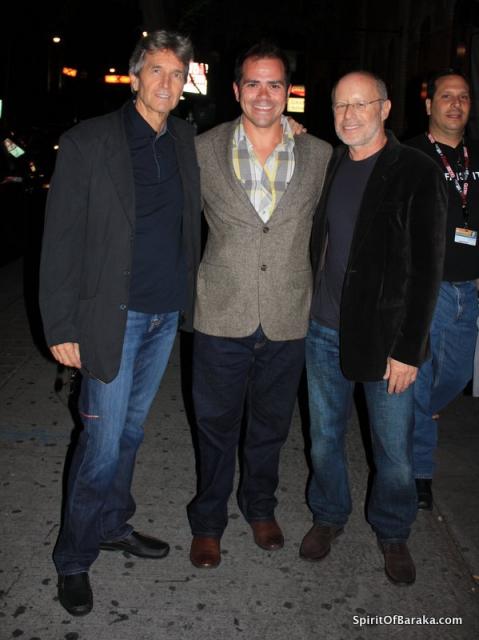
Thanks also to Abs, my girlfriend, for being a great travel companion, fashion advisor and photographer.
Pictured (left to right): Ron Fricke, Darren Lambert (SpiritOfBaraka.com), Mark Magidson.

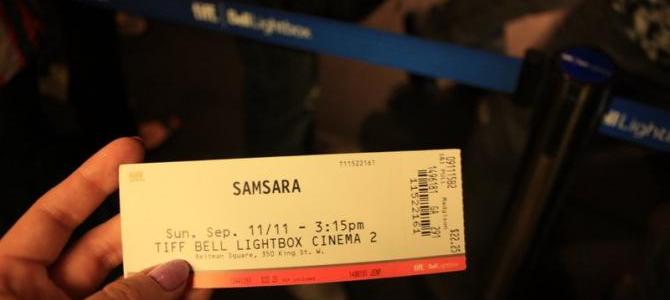
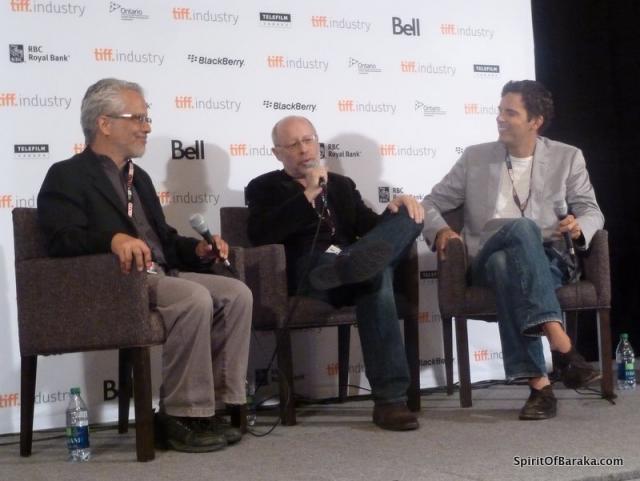
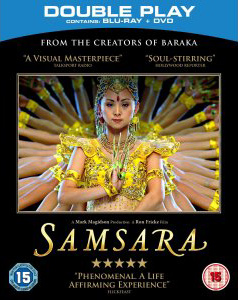

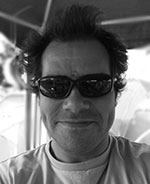 SpiritOfBaraka is brought to you by Darren Lambert. A huge fan of the these films.
SpiritOfBaraka is brought to you by Darren Lambert. A huge fan of the these films.